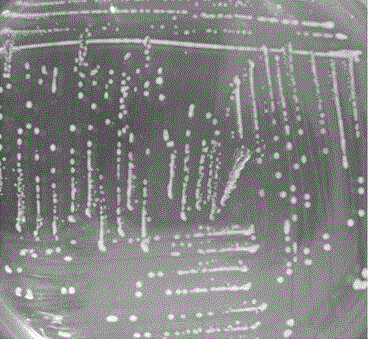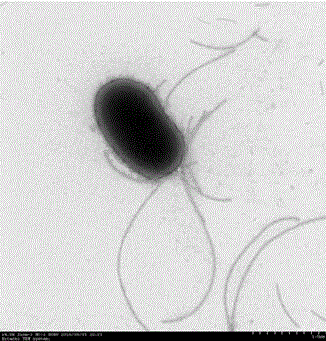Ginseng bacterium TY15-2 with effects of disease prevention and growth promotion and application thereof
A technology for ginseng rust bacteria and ginseng, which is applied in the field of microorganisms, can solve the problems of quality degradation, environmental pollution pathogen resistance, unsatisfactory control effect, etc., and achieves the effect of increasing fresh weight
- Summary
- Abstract
- Description
- Claims
- Application Information
AI Technical Summary
Problems solved by technology
Method used
Image
Examples
Embodiment 1
[0016] Example 1 Screening of bacterial strain TY15-2
[0017] Healthy ginseng roots were collected in Tonghua City, Jilin Province in October 2015. Screening of ginseng antagonistic strains was divided into primary screening and secondary screening. In the preliminary screening, 120 strains of endophytic bacteria and 178 strains of rhizobacteria were screened for antibacterial activity by the mixed bacteria method, and 1ml sterile water was added to ginseng rust rot bacteria ( Cylindrocarpon destructans ), Botrytis ginseng ( Botrytis cinerea ), Sclerotinia ginseng ( Sclerotinia schinseng ), Phytophthora ginseng ( Phytophthora cactorum ), Panax ginseng ( Alternaria panax ), ginseng root rot fungus ( Fusarium solani ), Panax ginseng ( Rhizoctonia solani ) In the PDA culture test tubes of 7 kinds of ginseng pathogenic bacteria, the mycelium and spores were scraped off with an inoculation needle, and the bacterial suspension was mixed with the PDA medium, and then p...
Embodiment 2
[0018] Identification of embodiment 2 bacterial strain TY15-2
[0019] Streak the TY15-2 strain on the NA medium, and culture it at 28°C to observe that the strain TY15-2 on the NA medium shows a light yellow opaque circular small colony with neat edges, such as figure 2 shown.
[0020] The TY15-2 strain cultured in NA medium was taken to prepare samples by negative staining, and it was observed under a transmission electron microscope that the bacteria were rod-shaped and had perinatal flagella, such as image 3 shown.
[0021] The physiological and biochemical characteristics of the TY15-2 strain were determined by referring to some culture media (Table 1) and methods recommended in the "Common Bacterial System Identification Manual" and "Berger System Identification Manual". It was found that the strain TY15-2 was Gram-negative bacteria ; Catalase, oxidase, V-P reaction is positive; can use citric acid, malonic acid to reduce nitrate; but can not hydrolyze starch, but ca...
Embodiment 3
[0024] Example 3 Determination of growth-promoting properties of bacterial strain TY15-2
[0025] 1. Determination of Nitrogen Fixation Capacity
[0026] Strain TY15-2 was streak-inoculated on Ashby solid medium, and cultured at 30°C to observe the growth of the strain. It was found that the strain TY15-2 grew well under nitrogen-free conditions and had nitrogen-fixing potential, such as Figure 5 shown.
[0027] 2. Determination of Potassium Solubilizing Ability
[0028] Inoculate the strain TY15-2 on a silicate solid medium and culture at 30°C to observe the size of the potassium solution circle, as shown in Figure 5 As shown, the strain TY15-2 has obvious potassium-dissolving circles; then, the strain TY15-2 was inoculated on the LB medium by flame photometry, and the absorbance value was measured after culturing for 12 hours. Quantitative measurement of its potassium content by flame photometer can reach 7.6 μg / mL.
[0029] 3. Determination of the ability to produce I...
PUM
 Login to View More
Login to View More Abstract
Description
Claims
Application Information
 Login to View More
Login to View More - R&D
- Intellectual Property
- Life Sciences
- Materials
- Tech Scout
- Unparalleled Data Quality
- Higher Quality Content
- 60% Fewer Hallucinations
Browse by: Latest US Patents, China's latest patents, Technical Efficacy Thesaurus, Application Domain, Technology Topic, Popular Technical Reports.
© 2025 PatSnap. All rights reserved.Legal|Privacy policy|Modern Slavery Act Transparency Statement|Sitemap|About US| Contact US: help@patsnap.com



